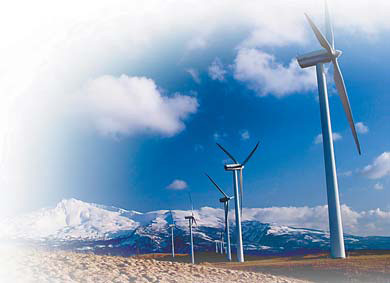Energy and Resources
The power of wind farms
(China Daily/Agencies)
Updated: 2009-08-17 08:03

As Deng Hui looked out at a forest of towering turbines dotting his company's wind farm north of Beijing, a cold, drizzly wind howled in his face, but he did not mind.
"That's the sound of money being printed," laughed Deng, general manager of the wind farm developed by State-owned China Energy Conservation Investment Corp.
A couple of years ago, only a few dozen of the 80-meter propeller-like turbines stood on the wind farm's vast open expanse of grass. Today, it has 200 and counting.
The facility's growth is but one example of the rising investments that have made China an emerging world leader in wind energy, with potentially huge benefits for the environment in both China and the world.
With close to 80 percent of China's energy supplied by cheap but heavily polluting coal, the government has announced ambitious plans to raise the use of renewable energy, such as the winds that rake northern and western China.
"It's not like people are still talking about wind as a potential future direction. It is already the way forward for a lot of power companies in China," said Yang Ailun, climate and energy campaign manager for Greenpeace China.
But the pace of wind energy's development in China has surpassed even the most optimistic projections.
After setting an original goal of 30 gigawatts (GW) of installed wind power by 2020, the government recently said that could be raised to 100 GW as installed capacity has doubled each of the last four years.
From almost nothing a few years ago, China had 12.2 GW of installed wind power by the end of 2008 as power companies rushed to meet government mandates to raise the proportion of energy they produce from renewable sources.
There are about 121 GW of installed wind power worldwide, according to the Global Wind Energy Council (GWEC), with the United States, Germany and Spain the top three wind power nations, followed by China.
In June, authorities in northern China's windswept Gansu province detailed plans for a "Three Gorges of Wind Power," a reference to the massive Three Gorges hydroelectric dam on the Yangtze River.
Installed capacity has grown so fast that it has outpaced the electrical grid's ability to accommodate the newly generated electricity, leaving much of the output of Deng's wind farm going to waste.
"Our nation's wind power has developed very fast, but the distribution system's development has lagged. This was an unavoidable problem with wind," he said.
Of China's 12.2 GW of installed power in 2008, only 8.9 GW of it became a part of the electrical grid, said Qiao Liming, GWEC policy director.
The problem has been exacerbated by the fact that wind farms in remote regions rich in the resource are too far from electrical grids.
"In the past two or three years, this has really become a serious problem in China," Qiao said.
Another issue is a project bidding process widely viewed as lacking transparency, and which sets wind electricity tariffs too low for wind farms to turn a decent profit, she said.
But the government has shown increasing concern about these hurdles and appears ready to solve them, Qiao said, noting that an economic stimulus plan announced last year will include heavy investments in electrical grid expansion.
"It's part of a process. Because of the huge wind farm development that just happened in recent years ... it takes some time for the government to really solve such issues," she said.











